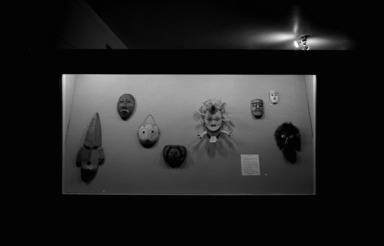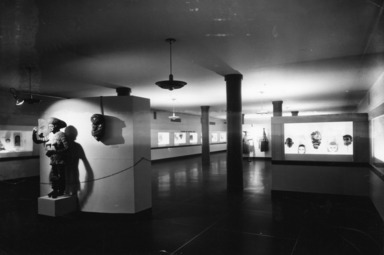

Masks: Barbaric and Civilized, October 28, 1939 through January 01, 1940 (Image: AON_E1939i001.jpg Brooklyn Museum photograph, 1939)
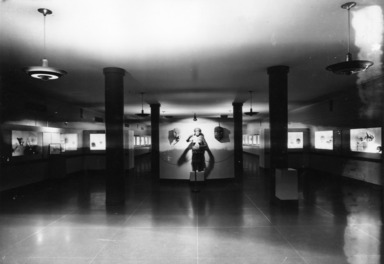
Masks: Barbaric and Civilized, October 28, 1939 through January 01, 1940 (Image: AON_E1939i002.jpg Brooklyn Museum photograph, 1939)
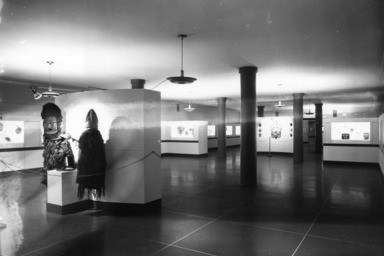
Masks: Barbaric and Civilized, October 28, 1939 through January 01, 1940 (Image: AON_E1939i003.jpg Brooklyn Museum photograph, 1939)
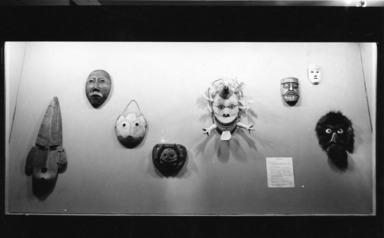
Masks: Barbaric and Civilized, October 28, 1939 through January 01, 1940 (Image: AON_E1939i004.jpg Brooklyn Museum photograph, 1939)
Masks: Barbaric and Civilized
DATES October 28, 1939 through January 01, 1940
ORGANIZING DEPARTMENT
Arts of Africa
COLLECTIONS
Arts of Africa
-
October 28, 1939
MAIN HALL (entrance to Special Exhibitions Gallery) left(first case left)
Thunder bird, a great patron who killed whales by throwing plumed serpents at them. Represents and Eagle and Thunder Bird. Brooklyn Museum Collection.
(right)
Masks of Aegus from “Oedipus Rex”, by Remp Bufano. Made from the design of Robert Edmond Jones.
Lent by: Peabody Museum, Harvard University.
FIRST SMALL GALLERY
(on walls)
Four Swiss carnival masks. These masks are worn by peasants on Shrove Tuesday in remote Swiss villages.
Lent by: Swiss Pavilion, New York World’s Fair
(against the screen and case to right of screen)
Modern beauty masks and masks for determining colors of lip sticks, rouge, etc.
Lent by: Elizabeth Arden, Inc.
(case to right at entrance to Special Exhibitions Gallery)
Carnival masks from Mexico Santiago, Salvador.
Lent by: Kenneth Macgown
American Museum of Natural History
Museum of the American Indian, Heye Foundation
(case to right, entrance to small exhibition gallery)
Four modern American Halloween masks
Four Mexican carnival masks, two of wood and two of tin.
Lent by: Kenneth Macgown (one)
(three) Brooklyn Museum collection.
(case to left, entrance to small exhibition gallery)
Reproduction of American 19th century linen and velvet masks worn by ladies for protection against the sun. Ingredients and instruments used in 19th century beauty preparations. Brooklyn Museum collection.
SPECIAL EXHIBITIONS GALLERY
Masks for protection
Greek war helmet with protective nose piece
Brooklyn Museum collection.
Helmet (Armet), German 1525.
Lent by: Metropolitan Museum of Art
Italian siege helmet. 17th century.
Lent by: The Metropolitan Museum of Art.
English helmet, 17th century.
Lent by: The Metropolitan Museum of Art.
Combination masks and helmets were worn by the ancient Greeks as well as Medieval knights for protection in warfare and tilting.
(second case left)
Japanese face masks worn with full sets of armor to insure protection in warfare. One mark is shown together with helmet. 18th and 19th century.
Brooklyn Museum collection.
(third case left)
Japanese fencing mask.
Brooklyn Museum collection.
American modern fencing mask.
Lent anonymously.
Sterilized cotton surgeon’s mask.
Lent by Regent Hospital, New York.
Wooden Eskimo sun mask.
Brooklyn Museum collection.
Baseball catcher’s mask.
Lent by Brooklyn National League Baseball Club, Inc. (“Dodgers”)
(fourth case left)
Industrial and military masks.
Civilian gas mask, Army gas mask, industrial respirator, industrial respirator with hood.
Lent by: Pulmosan Safety Equipment Corporation, Brooklyn.
Theatrical Masks (right)
(case one) right
Classical, terra cotta and. bronze masks . These were mace for architectural purposes but represent the of masks used in theatrical preformances
Lent by: (two) University Museum. Philadelphia.
Remainder including mould and mask made from Brooklyn Museum collection.
(case two) right
Two masks used in Japanese No performances
Brooklyn Museum collection.
Four masks used in Kyogen performances.
Brooklyn Museum collection.
One Chinese theatrical mask.
Lent by the American Museum of Natural History.
One Chinese theatrical mask.
Brooklyn Museum collection.
No dances are courtly performances telling stories of ancient Japanese heroes. Performed on special stage by masked actors wearing gorgeous clothes. Kyogen performances are interludes between longer No performances.
(case three) right
Two masks used in Siamese classical drama.
Lent by: Thailand Pavilion (Siam). New York World’s Fair.
Six Bali drama masks.
Lent by: American Museum of Natural History, Belo-McPhee Collection.
(case four) right
Masks made and lent by Margaret Severn, American dancer. Mask worn by her in European and American performances.
(case five and six) right
Masks made and lent by T. Benda. Used in the theatre, pantomime dance and motion pictures.
Death Masks
(case five-left of entrance)
Ptolemaic Cartonnage mask.
Brooklyn Museum collection.
Greco-Egyptian Portrait with Egyptian headdress.
Brooklyn Museum Collection.
Fayum portrait Encaustic of the Lady Demetris
Brooklyn Museum collection
Greco-Egyptian portrait mask
Brooklyn Museum collection.
Greco-Egyptian portrait mask
Brooklyn Museum collection
RELIGIOUS AND CEREMONIAL SCREEN (first)
Front
Likishi dancer’s costume worn at initiation ceremony.
Barotse tribe, Rhodesia, Africa
Brooklyn Museum collection
Maori wooden architectural mask.
Brooklyn Museum collection
Oversize wooden mask from burial cave. Aleutian Islands.
Lent by: Museum of the American Indian, Heye Foundation.
Rear
Six masks used in Javanese theatrical performances.
Lent by: (five) American Museum of Natural History.
(one) Brooklyn Museum collection.
Miniature masks of type used by medicine men in Ceylon to out demons from sick men.
Lent by: American Museum of Natural History
(case seven) right of entrance
This type is worn in Ceylon in all night ceremonial dances by medience men to drive out demons from the sick.
Lent by (one) American Museum of Natural History (three) Brooklyn Museum collection.
(case eight) right
From Tibet. Worn by monks in devil dances and mystic plays performance in temple courtyard to exercise demons and to teach religious history.
Lent by: (two) American Museum of Natural History (one) Brooklyn Museum collection.
(case nine) right
From Tibet. Masks worn by monks in devil dances and mystical plays performed in temple courtyards to exorcise demons and to teach religious history.
Lent by: American Museum of Natural History.
(case ten) right
Primitive South American masks. Used in ceremonial dances. Two represent Araucanian culture in Chile; one from the Xingu River, on Wai Wai Indians in Brazil and one from Santa Marta mountains of Colombia.
Lent by: University Museum, University of Pennsylvania.
(case eleven) right
From Melanesia – Island of New Caledonia, New Guinea, and New Britain. Ceremonial masks.
Lent by: (three) American Museum of Natural History
(one) Philadelphia Commercial Museum
(one) University Museum, Philadelphia
(one) Brooklyn Museum collection.
(case twelve) right
Those masks representing people who have recently died are used in the annual ceremonies honoring the dead. From New Ireland.
Lent by; (one) Kenneth Macgowan
(one) Universtiy Museum, University of Pennsylvania.
(one) Brooklyn Museum collection.
(case thirteen) right
These masks from the Belgian Congo and the Ivory Coast, Africa.
Ceremonial masks.
Lent by: (two) Peabody Museum, Harvard University
(two) Brooklyn Museum collection
(one) American Museum of Natural History.
(case fourteen) right
Masks used in ceremonial dances. From the Kasai region and other parts of the Belgian Congo, Africa.
Lent by: (one) Kenneth Macgowan
(one) American Museum of Natural History.
(one) Brooklyn Museum collection.
(case fifteen) right
Ceremonial dance masks. From the Belgian Congo, Yoruba, and Ivory Coast.
Lent by: (four) Brooklyn Museum collection
(one) Christian Rub, California.
(case sixteen) right
Zuni masks and dolls. The dolls show the complete costumes including the masks of the dancers.
Brooklyn Museum collection.
(case sixteen) left
Hopi Indian, Southwest. These masks represent doors, frogs and various gods.
Brooklyn Museum collection.
(case fifteen) left
Apache Indian, Southwest. Represent important deities, especially those included in the Night Chant.
Brooklyn Museum collection.
(case fourteen) left
Iroquois Indian, New York. False Face Society.
Lent by: Rochester Museum.
Cornhusk mask, Cayuga.
Lent by: American Museum of Natural History.
Seneca mask.
Lent by: American Museum of Natural History
Wood mask, Cherokee Indian
Lent by: Museum of the American Indian, Heye Foundation.
(case thirteen) left
Northwest Coast. Kwakiutl, Tlingit, Chilkat tribes.
Lent by: (two) American Museum of Natural History
(two) Brooklyn Museum collection
(case twelve) left
Northwest Coast – Tlingit and Kwakiutl tribes. One copper and three wood. Treatment is enchanced by the use of abalone shell.
Lent by: (two) American Museum of Natural History
(one) Peabody Museum, Harvard University
(one) Museum of the American Indian, Heye Foundation
(case eleven) left
Indian – Eastern United States. One deer mask of the Penobscot, two Cherokee masks of wood and skin, one skin mask from Eastern Eskimo, Nain, Labrador, one wooden mask from Eastern Greenland.
Deer masks are used in dances to bring luck in hunting.
Lent by: (four) Museum of the American Indian, Heye Foundation
(one) University Museum, University of Pennsylvania
(case ten) left
Western Eskimo. Elaborate wooden masks with figures paddling boats, etc. affixed to the masks.
Lent by: (one) American Museum of Natural History.
(one) Peabody Museum Harvard University.
(case nine) left
Eskimo masks. King Island, Alaska. Wooden masks of facial types also spirit and owl masks as well as finger masks decorated with feathers.
Lent by: (two) University Museum, University of Pennsylvania.
(two) Kennth Macgowan
(four) American Museum of Natural History.
(case eight) left
Mexican masks. Sepulchral masks made of onyx, serpentine and marble.
Lent by: (two) Museum of the American Indian, Heye Foundation
(four) Brooklyn Museum collection
(case seven) left
Maya gold mask from Chichen Itza, found in the Second Cenote.
Shell mask of the Mound Builders from Tennessee, votive mask of wood from the Spiro Mound, Oklahoma, Mexican clay mask, and models of architectural masks from Chichen Itza.
Lent by: (one) Museum of the American Indian, Heye Foundation
(three) Brooklyn Museum collection
(two) Peabody Museum, Harvard University
(case six) left
South American masks . Bronze mask from Ecuador, clay mask from Esmeraldas, Ecuador, Gold mask, Chimu culture, Peru, mask with shell eyes, silver mask from a mummy bundle, Chincha, Peru, wooden mask form Lambayeque, Peru.
Lent by: (one) Mr. Ernesto Franco
(two) Dr. Schmidt-Pizzaro through courtesy of the H. H. de Young Memorial Museum, San Franciso, California
(one) Museum of the American Indian, Heye Foundation
(one) Brooklyn Museum collection
(one) anonymously
On screen – second (front)
Entire-costume masks, one representing a butterfly and the other a bird eating a spider. Worn by a tribe in the Rio Caiary-Uaupes Brazil.
Lent by: Philadelphia Commercial Museum
American Museum of Natural History.
Rear
New Caledonia dance mask with body covering of feathers.
Lent by: Philadelphia Commercial Museum
Bush devil mask and costume from Liberia
Lent by: American Museum of Natural History
Basket mask from New Guinea
Lent by: University Museum University of Pennsylvania.
SMALL GALLERY AT REAR OF SPECIAL EXHIBITIONS GALLERY
Right (two cases)
Southwest Pueblo Indian. Masks worn in dances.
Brooklyn Museum collection
Left
(case one)
Dance masks from Shebro, West Africa and South Africa.
Lent by: (one) University Museum, University of Pennsylvania
Brooklyn Museum collection.
(case two)
Masks from the Yoruba and Belgian Congo. Copper mask from Benin.
Brooklyn Museum collection.
(on pedestal)
Costume for Likishi dance. Rhodesia, Africa.
Lent by: Philadelphia Commercial Museum.
Brooklyn Museum Archives. Records of the Department of Public Information. Press releases, 1939 - 1941. 09-10/1939, 262-71.
View Original -
October 28, 1938
The first comprehensive exhibition of its kind, according to the records, will be “Masks---Barbaric and Civilized” which will be staged at the Brooklyn Museum from Wednesday, October 25th, through January 1, 1940. It will be a complete and dramatic presentation of masks from earliest times to the present day and is arranged in five groups. A great part of the material will be taken from the Museum’s own collections, which are plentifully supplied with masks, and will be augmented by special loans.
Scholars claim that masks and similar disguises were probably invented from 12,000 to 20,000 years ago by man living in Southern Europe during the last great Ice Age. At that time they were used as religious objects in man’s battle with the spirits. The earliest masks in the exhibition will be from the 1st Century B.C. The exhibits will trace the use of masks from the religious and ceremonial through their use in folk dances, carnivals, pageants, the theatre and. architectural decoration to their protective role in industry and war, as well as for recording faces in death and for enhancing beauty.
Through this plan masks will be shown from many nations and periods, and for many purposes. The various groupings will be religious, buffonery and carnival, theatre, protection and beauty. The last category will be demonstrated through masks lent by Elizabeth Arden, Inc.
Religious and ceremonial masks will include specimens from Tibet, Ceylon, the South Seas, Africa and the Indians of the Americas including Mayas end Aztecs; buffonery and carnival, contemporary mummers, halloween and Alpine masks, certain masks of the southwest Indians, European 18th Century carnival masks, the later probably illustrated in prints and paintings; theatre will include Roman, Javanese, Chinese, Siamese and contemporary European and American ones, the last exemplified by those developed by W. T. Benda and Margaret Severn, the dancer, which will be lent; protection will include European and Japanese armor masks, Northwest coast Indian masks, two respirators for miners as protection against dust, a hooded miner’s mask and the all familiar gas masks, which will include the army type. Still others in this class will be a baseball catcher’s mask, a Ku Klux Klan hood, a fencing and a highwayman’s mask.
Brooklyn Museum Archives. Records of the Department of Public Information. Press releases, 1939 - 1941. 09-10/1939, 234.
View Original -
October 23, 1939
For reviewers who consider that the Mask Exhibition at the Brooklyn Museum falls in their field, it will be possible to see the show for review from Monday morning, October 23rd, on. Catalogue by Dr. Spinden and a list of exhibits and photographs will be available at that time. The general news release of the opening is being mailed out to everyone and marked for release Wednesday, October 25th, the day of the public opening.
Brooklyn Museum Archives. Records of the Department of Public Information. Press releases, 1939 - 1941. 09-10/1939, 258.
View Original -
October 24, 1939
The names listed below are selected from the acceptances received by the Brooklyn Museum to its invitation for the private opening of the exhibition “Masks---Barbaric and Civilized” on Tuesday evening, October 24th, at 9:00 P.M.
Mrs. James N. Currie
Mrs. R. Edson Doolittle
Mr. Conrad V. Dykeman
Mr. and Mrs. Frederic B. Pratt
Miss Julia F. Ring
Miss Nina D. Schall
Mrs. Charles A. Soper
Mr. W. T. Benda
Captain and Mrs. E. Phineas Huff
Mrs. Marion P. North
Miss Mary C. Tinney
Mr. and Mrs. Howard W. Vernon
Miss Mary Campbell
Mrs. August W. Comstock
Mr. Albert Conway
Mrs. Mary Bentley Felter
Dr. George G. Heye
Miss Malvina Hoffman
Mr. William Baylis
Mr. and Mrs. Edward C. Blum
Mr. Walter H. Crittenden
Miss Lucille Fawcett
Dr. and Mrs. C. Stuart Gager
Mrs. H. W. Henan
Mr. Edward M. N. Warburg
Dr. Davenport Hooker
Mr. Remo Bufano
Mrs. William H. Good
Mr. Alan Priest
Mr. Victor Nef
Mr. Luang Thavil
Miss Elizabeth Arden
Miss Margaret Severn
Mrs. William C. Knoll
Mrs. Louis H. Emerson
Dr. H. N. Lydenberg
Brooklyn Museum Archives. Records of the Department of Public Information. Press releases, 1939 - 1941. 09-10/1939, 254.
View Original -
September 16, 1939
Ten exhibitions are already on the Brooklyn Museum’s exhibition schedule for the 1939-1940 season. As an opener, in order to be current with the style news, an exhibition of a more or less preliminary character opened on Saturday, September 9th, called Style Foundations--Corsets and Fashions of Yesterday and Today, to run through October 1st.
The first exhibition of the season opens on Friday, September 22nd, and will be called “Long Island in the 70’s". It will be a showing of some 160 prints of Brooklyn and Long Island scenes taken from a collection of over 2000 negatives of scenes in Long Island, Connecticut, New Jersey and the Hudson Valley, taken by George B. Brainard and acquired by the Museum twenty years ago. Only recently these negatives were brought to light by the Photographic Department. It will exhibit a cross section of the Long Island subjects and will demonstrate the character of the hundreds of records that Brainard made during his busy photographing days. Closing date is October 8th.
In memory of William A. Putnam, who made possible the Museum’s Print Room, an exhibition will be arranged to be called “The Putnam Memorial Print Exhibition” to run from October 7th through the 29th. It will consist of prints by Rembrandt, the gift of Mr. and Mrs. Putnam, and other graphic material from the Brooklyn Museum collection.
The year’s accessions will be put on view from Saturday, October 14th, through Sunday, the 29th.1 This will be followed by the first large comprehensive show of the season which will be as complete a collection as possible of masks, drawing for the most part from the Museum’s own possessions. The masks are to be shown in groups according to use. The exhibition will run from Tuesday, October 24th, to Monday, January 1st.
Following will be a watercolor exhibition which will form a memorial to both George Pearse Ennis and Paul L. Gill. This will be shown from Saturday, November 4th, through Sunday, November 26th. This is the last opening scheduled for the calendar year. After the first of the year on Wednesday, January 17th, there will be an extensive showing of the work of Eastman Johnson to run through Sunday, February 25th. Work has been under way for several months to collect examples of this painter that have not been shown before.
On February 9th an exhibition of etchings by Rodolphe Bresdin will be put on view through Sunday, March 31st.
The second large exhibition of the year will be a complete costume show, drawn, as the mask exhibition will be, principally from the Museum’s own collection. This exhibition will open on Tuesday, March 12th, and continue through Sunday, May 5th.
The last exhibition to open this season according to the present schedule will be that of Brooklyn Artists, which will be on view from Friday, April 5th, to Sunday, the 28th. From time to time there will be small special exhibitions that will take form during the season.
LIST BELOW, ABOVE INFORMATION IN TABULAR FORM
Style Foundations---Corsets and Fashions of Yesterday and Today. September 9th through October 1st.
Photographs by George B. Brainard. “Long Island in the 70s.” September 22nd through October 8th.
Putnam Memorial Print Exhibition. October 7th through October 29th.
Recent Accessions. October 14th through October 29th.
Masks, October 24th through January 1st.
George Pearse Ennis and Paul L. Gill Watercolor Exhibition. November 4th through November 26th.
Eastman Johnson Exhibition. January 17th through February 25th.
Rodolphe Bresdin Exhibition. February 9th through March 31st.
Costume Show. March 12th through May 5th.
Brooklyn Artists. April 5th through April 28th.
Brooklyn Museum Archives. Records of the Department of Public Information. Press releases, 1939 - 1941. 07-09/1939, 204-5.
View Original -
October 25, 1939
The first comprehensive exhibition of masks on record opened last night (Tuesday, Oct . 24th) at the Brooklyn Museum with a reception at 9:00 o’clock for guests invited by the President and the Trustees of the Brooklyn Institute of Arts and Sciences. The show, which is in the Gallery of Special Exhibitions off the entrance hall, opens to the public today (Wednesday, October 25th) and will continue through Sunday, January 1st.
The title, “Masks---Barbaric and Civilized”, describes the content of the exhibition which is made up of over 150 masks of nearly all possible countries and periods. The exhibition was planned to give an insight into perpetual interest in assuming false faces for the purposes revealed in the six categories into which the show is divided: Religious and Ceremonial, Theatre, Self-Preservation or Protection, Carnival and Buffoonery Beauty, and Death
An illustrated catalogue in the form of a handbook on the subject has been prepared by Dr. Herbert J. Spinden, Curator of American Indian Art and Primitive Cultures, who was in charge of the arrangement of the exhibition jointly with Laurence F. Roberts, Director of the Museum and Curator of Oriental Art.
Most of the masks are taken from the Museum’s own collections but several loans have been made to round out the story. The lenders are: American Museum of Natural History, Belo-McPhee Collection, American Museum of Natural History; Museum of the American Indian, Heye Foundation, The Metropolitan Museum of Art; Peabody Museum of Archeology and Ethnology, Harvard University; Peabody Museum, Salem Massachusetts; Philadelphia Commercial Museum; The Rochester Museum of Arts and Sciences University Museum, University of Pennsylvania, Philadelphia; H. M. de Young Memorial Museum, San Francisco; Elizabeth Arden, Incorporated; Mr. T. Benda; Brooklyn National League Baseball Club Incorporated; Mr. Remo Bufano; Dr. Ernesto Franco; Mr. Kenneth MacGowan; Pulmosan Safety Equipment Corporation, Brooklyn; Regent Hospital, New York City; Mr. Christian Rub; Mr. Schmidt-Pizzaro; Miss Margaret Severn; Mr. William Spratling; Swiss Pavilion, World’s Fair; and the Thailand (Siam) Pavilion, World’s Fair.
The arrangement is by thirty six small groups in cases with concealed lighting along the entire walls of the large gallery. Two free standing, specially lighted backgrounds arc used to display full figure costumes surmounted by masks.
As masks are a direct link between the modern world and the past, the Brooklyn Museum exhibition is designed so that the public can explore graphically a rich field hitherto known only to scholars. To do this the Museum has begun with Egyptian mummy masks and carried the development through to contemporary gas, beauty, and sports masks.
Modern Halloween masks, one of which is a “Charlie McCarthy”, are contrasted with early European carnival masks of the 17th and l8th centuries, A baseball catcher’s mask, lent by the Brooklyn “Dodgers”, a 19th century Japanese fencing mask, helmets worn by medieval knights, an Eskimo sun-mask, precursor of present-day ski goggles, a surgeon’s operating-room mask lent by Regent Hospital and the latest typos of civilian, industrial and army masks are in the “protective” section. Among the theatrical masks are examples from the Javanese, Chinese, Japanese, Greek and Roman theatre; while the modern is represented by the creations of W. T. Bond and Miss Margaret Severn, the dancer. Modern facia1 beauty masks lent by Elizabeth Arden, Inc., are shown together with the accompanying beauty preparations, while the 18th and 19th century skin protecting beauty masks have with then the ingredients for an old skin-bleaching recipe.
From the Museum’s own extensive collections come the many specimens from Tibet, Ceylon, the South Seas, Africa and the Indians of North, Central and South America. In the Death Mask division there is a Ptolemaic cartonnage, or mummy covering, mask from about 200 B.C., the Fayum portrait discovered on a forgotten mummy in an old storeroom in the Museum and restored and cleaned in time for this occasion, and many stone, gold and silver Death masks from South America which all date from before the time of Columbus. One example from Africa can hardly be classed as a false face since it is made from an actual human skull.
Masks like the Polynesian and South American ones in the exhibition are still being used in the South Seas and parts of South America where culture has never risen above the Stone Age level, In the Stone Age caves in France are pictures of medicine men wearing animal masks and performing magical ceremonies connected with the religion of the time which are similar to the ceremonies and religion in which these masks are used.
Though masks for religious and ceremonial magic purposes are the oldest known, most of the masks of primitive peoples are worn when death is imminent or has taken place. A set is included such as aroused by medicine men in Ceylon to drive away the demons of sickness when all else has failed. The masks from Egypt were used to represent the deceased on their mummy cases, a practice that began during the Middle Kingdom. The same desire to preserve the features of the dead for posterity led to the practice so popular in America in the early 19th century of having masks cast on the face after death. A typical American example is also included.
Examples of the face masks that word part of every suit of Japanese armor and of those used by medieval knights in battle arid in jousting are on view, together with their modern counterpart, the gas mask.
The 20th century has seen a revival of theatrical masks, notably the exotic masks of U. T. Benda and those of the dancer, Margaret Severn. Masks by Miss Severn and Mr. Benda are shown in cases next to those used in the classical drama of Java, Bali and Siam and in the performances of Japan. The Benda are masks by casting papier mache. The whole process takes to and the completed object is valued t one thousand dollars Miss Severn, one of the best known exponents of dancing with masks, who ht first danced with Benda masks, now creates her own by her own process which consists of building thorn up with small pieces of paper over a form. The four that are in the show had their debut in the Opera Comique in Paris.
In the Swiss Alpine carnival examples, lent by the World’s Fair Swiss Pavilion are soon the same kind of masks worn in the same localities during to Middle Ages though today their use is dying out. Mexico also contributes interesting examples of carnival masks of wood and tin, both old and contemporary. The Halloween and fancy dress masks on view indicate the way this custom of carnival-masking has continued in an unbroken line from very early periods both in Europe and in this country.
Brooklyn Museum Archives. Records of the Department of Public Information. Press releases, 1939 - 1941. 09-10/1939, 255-7.
View Original
